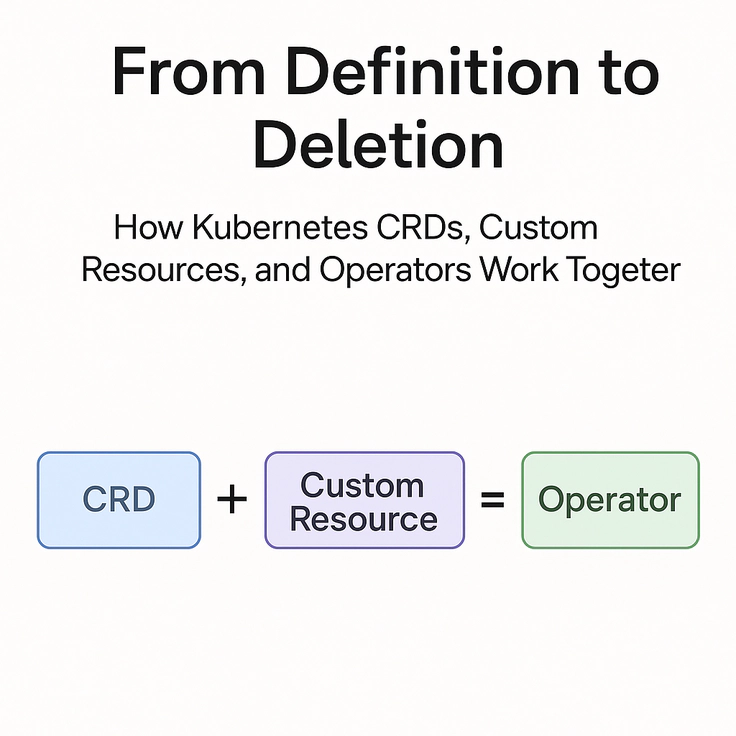Demystifying Kubernetes: CRDs, Custom Resources, and the Reconciliation Loop
From Definition to Deletion — How Kubernetes CRDs, Custom Resources, and Operators Work Together ⚙️

Kubernetes isn’t just about Pods, Deployments, and Services—it’s a framework for building powerful, extensible APIs. And at the heart of that extensibility are Custom Resource Definitions (CRDs), Custom Resources (CRs), and the controllers/operators that breathe life into them.
If you’ve ever wondered how CRDs get applied, how controllers “magically” keep resources in sync, and what happens when they’re deleted, this post will walk you through the full lifecycle—from YAML to reconciliation to finalization.
1. CRDs: Extending the Kubernetes API
Custom Resource Definitions (CRDs) Custom Resource Definitions (CRDs) are Kubernetes’ way of letting you define new API objects—your own resource types—without modifying Kubernetes’ core code.
For example, you might create a CRD called Backup that represents a database backup job. Once the CRD is registered, you can create Backup resources in your cluster just like you create Pods or Deployments.
Here’s a simple CRD snippet:
apiVersion: apiextensions.k8s.io/v1
kind: CustomResourceDefinition
metadata:
name: backups.example.com
spec:
group: example.com
names:
kind: Backup
plural: backups
singular: backup
scope: Namespaced
versions:
- name: v1
served: true
storage: true
schema:
openAPIV3Schema:
type: object
properties:
spec:
type: object
properties:
database:
type: string
schedule:
type: string
Once this CRD is applied:
kubectl apply -f backup-crd.yaml
Now Kubernetes knows about a new resource type: backups.example.com.
kubectl get backups
kubectl describe backup my-daily-backup
2. Custom Resources: Instantiating Your API
Custom Resource (CR) is an actual instance of your new type—like a Pod is an instance of PodSpec.
Example Backup CR:
apiVersion: example.com/v1
kind: Backup
metadata:
name: my-daily-backup
spec:
database: postgres-prod
schedule: "0 2 * * *"
You apply it with:
kubectl apply -f backup-cr.yaml
At this stage, the resource exists in etcd (Kubernetes’ data store), but it doesn’t actually do anything yet. That’s where controllers/operators step in.
3. Controllers & Operators: The Brain Behind the API
A controller in Kubernetes is a process that watches the API server for changes to resources and takes action to move the cluster towards the desired state.
When we talk about Operators, we’re usually talking about a controller + domain-specific logic to manage complex applications (databases, message queues, etc.).
Here’s how it works under the hood:
Watch: The controller subscribes to resource events (
ADDED,MODIFIED,DELETED) using the Kubernetes API.Queue: When something changes, it’s queued for processing.
Reconcile: The controller runs a reconciliation loop, comparing the desired state (your CR spec) with the current state (the real world), then making adjustments.
Repeat: The loop is continuous—Kubernetes never assumes the world is in the right state.
4. The Reconciliation Loop in Action
Imagine you created the Backup CR above. The reconciliation loop might:
- Check if a CronJob exists for
postgres-prodat 2 AM. - If not, create it.
- If it exists but the schedule is wrong, update it.
- If the database name changed, trigger a redeployment of the backup job.
This loop ensures eventual consistency—even if something breaks or gets deleted outside Kubernetes, the controller will put it back to match the CR’s spec.
A simplified pseudocode example:
func Reconcile(backup Backup) {
if !cronJobExists(backup) {
createCronJob(backup)
} else if scheduleChanged(backup) {
updateCronJob(backup)
}
}
5. Finalizers: Graceful Deletion
When you delete a CR, Kubernetes doesn’t immediately remove it from etcd if it has a finalizer. Instead:
- The deletion timestamp is set.
- The controller sees the resource is “pending deletion”.
- The controller runs clean-up logic (e.g., delete backup files from cloud storage).
- The controller removes the finalizer from the resource.
- Kubernetes completes the deletion.
Example finalizer in a CR:
metadata:
finalizers:
- backups.example.com/finalizer
This ensures external resources aren’t left dangling when the CR is removed.
6. Bringing It Together
The lifecycle looks like this:
CRD applied → CR created → Controller reconciles state
↓ ↓ ↓
API extended Desired state World matches
declared desired state
And when deleting:
kubectl delete CR → Finalizer runs → Resource gone
7. Why This Matters for Cloud Engineers & DevOps
Understanding CRDs, CRs, and the reconciliation/finalization process lets you:
- Build custom Kubernetes APIs for your org’s workflows.
- Automate operational tasks (backups, scaling, provisioning).
- Safely clean up external resources without manual intervention.
- Debug operator behavior when things go wrong.
At its core, Kubernetes is not just an orchestrator—it’s a control loop platform. Mastering CRDs and controllers turns Kubernetes into a programmable, self-healing infrastructure layer.
